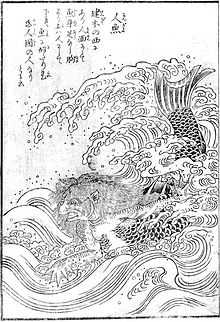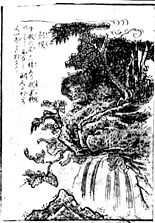Konjaku Hyakki Shūi
Konjaku Hyakki Shūi (今昔百鬼拾遺, "Supplement to The Hundred Demons from the Present and the Past") is the third book of Japanese artist Toriyama Sekien's Gazu Hyakki Yagyō series, published ca. 1781. These books are supernatural bestiaries, collections of ghosts, spirits, spooks and monsters, many of which Toriyama based on literature, folklore, and other artwork. These works have had a profound influence on subsequent yōkai imagery in Japan.
List of creatures
The three volumes were titled Cloud (雲), Mist (霧), and Rain (雨).
First Volume - Cloud
-

Shokuin (ja:燭陰) is the spirit of China's Purple Mountain. It appears as a red, man-faced dragon, a thousand ri tall.[2]
-
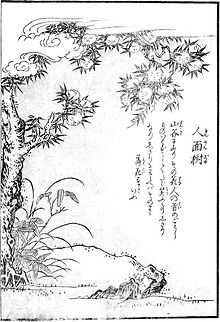
Ninmenju (人面樹, human-faced tree) is a tree which grows in remote mountains recesses, with flowers that resemble human faces. hese faces are always smiling, even as they fall from their branches.[3]
-

Tengutsubute (ja:天狗礫, tengu throwing stones) is a phenomenon in which stones are suddenly thrown through the air somewhere deep in the mountains. It is thought to be the work of the tengu.[7]
-

Dōjōjinokane (道成寺鐘, the bell of Dōjōji temple) is the bell which was melted by Kiyohime, a woman who fell in love with a young priest, and through the rage of unrequited love became a terrible serpent demon. When the priest fled and hid underneath this temple bell, the serpent surrounded the bell and destroyed herself and her would-be lover in flames of her rage.[8]
-

Dorotabō (ja:泥田坊, muddy rice field fellow) is the ghost of an old man who worked hard to pass on his rice fields to his descendants. His children squandered the fields and sold them to someone else, and so the old man appeared in the fields as a black, one-eyed creature crying for his rice fields to be returned.[10]
-

Kokuribaba (ja:古庫裏婆, hag of the old priest's quarters) was a woman who came to a mountain temple and was called the head priest's wife, because she lived in his quarters. She stole rice and money from the people who came to the temple, and as punishment became a terrible demon hag who eats the skin from corpses.[11]
-

Oshiroibaba (ja:白粉婆, face-powder hag) is an old woman who is the assistant of Jibun Senjō, the spirit of face powder. She walks through the snow during the twelfth month of the lunar calendar, wearing an oversized sugegasa hat.[12]
-

Jakotsubaba (ja:蛇骨婆, snake-bone hag) is an old woman who holds a red snake in her left hand and a blue snake in her right hand. She guards a certain "snake mound", possibly because she is the wife of a monstrous serpent named "Jagoemon" who is sealed there.[13]
-

Kerakeraonna (ja:倩兮女)
Cite error: There are <ref> tags on this page, but the references will not show without a {{reflist}} template (see the help page).
Second Volume - Mist
-

Momiji (紅葉狩) is the demon-woman of Mount Togakushi.[1]
-

Oboroguruma (ja:朧車) is an oxcart with a huge human face on the front, which appears on hazy moonlit nights in Kyoto.[2]
-

Minobi(ja:蓑火)
-

Aoandon (ja:青行燈) The spirit of the blue paper lantern.
-

Ameonna(ja:雨女) Rain making female spirit.
-

Kosamebō(ja:小雨坊)
-

Gangikozō (ja:岸涯小僧)
-

Ayakashi(あやかし)
-

Kidō (鬼童)
-
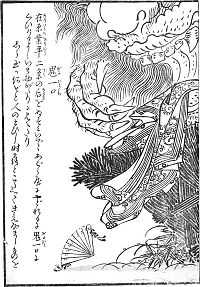
Onihitokuchi (ja:鬼一口)
-

Jatai (ja:蛇帯)
-

Kosodenote (ja:小袖の手)
-

Hatahiro (ja:機尋)
-

Ōzatō (ja:大座頭)
-

Himamushinyūdō (火間蟲入道)
-

Sesshōseki (ja:殺生石)
-
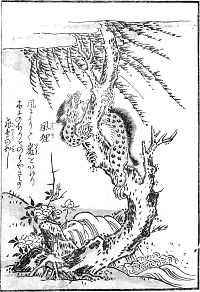
Fūri (ja:風狸)
-

Morinjinokama (ja:茂林寺釜)
Cite error: There are <ref> tags on this page, but the references will not show without a {{reflist}} template (see the help page).
Third Volume - Rain
-

Rashōmon-no-oni (Oni of Rashōmon, 羅城門鬼)
-

Yonakinoishi (夜啼石)
-

Bashōnosei (ja:芭蕉精)
-

Suzuri-no-tamashii (ja:硯の魂)
-

Byōbunozoki (屏風覗)
-

Keukegen A small dog-like creature covered entirely in long hair.
-

Mokumokuren A swarm of eyes that appear on a paper sliding door in an old building.
-

Kyōkotsu (ja:狂骨)
-

Mekurabe (ja:目競)The multiplying skulls that menaced Taira no Kiyomori in his courtyard.
-

Ushirogami (ja:後神)
-

Iyaya (ja:否哉)
-

Hōsōshi (方相氏)
-

Takirei-ō (ja:滝霊王)
-

Hakutaku A beast which handed down knowledge on harmful spirits.
-

Kakurezato (ja:隠里)
References
- Toriyama, Sekien (2005). Toriyama Sekien Gazu Hyakki Yagyō Zen Gashū. Kadokawa Sophia Bunko (in Japanese). Kadokawa Shoten. ISBN 978-4-04-405101-3.
- Natsuhiko Kyogoku and Katsumi Tada (ja:多田克己) (2000). Yōkai Zukan (in Japanese). Kokusho Kankokai (ja:国書刊行会). ISBN 978-4-336-04187-6.
- Kenji Murakami (ja:村上健司) (2000). Yōkai Jiten (in Japanese). Mainichi Shimbun. ISBN 978-4-620-31428-0.
See also
| Wikimedia Commons has media related to Konjaku Hyakki Shūi. |

